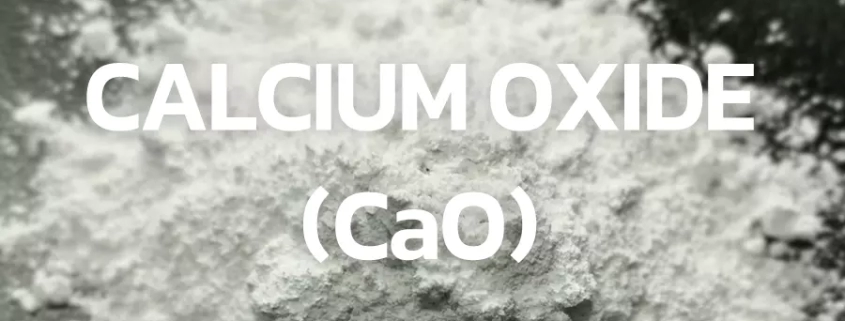CALCIUM OXIDE (CaO)
Calcium oxide (CaO), commonly known as quicklime or burnt lime, is a widely used chemical compound. It is a white, caustic, alkaline, crystalline solid at room temperature. The broadly used term “lime” connotes calcium-containing inorganic materials, in which carbonates, oxides, and hydroxides of calcium, silicon, magnesium, aluminum, and iron predominate. By contrast, quicklime specifically applies to the single chemical compound calcium oxide. Calcium oxide that survives processing without reacting in building products such as cement is called free lime.
Quicklime is relatively inexpensive. Both it and the chemical derivative calcium hydroxide (of which quicklime is the base anhydride) are important commodity chemicals.
Uses CALCIUM OXIDE (CaO):
- The major use of quicklime is in the basic oxygen steelmaking (BOS) process. Its usage varies from about 30 to 50 kilograms (65–110 lb) per ton of steel. The quicklime neutralizes the acidic oxides, SiO2, Al2O3, and Fe2O3, to produce a basic molten slag.
- Ground quicklime is used in the production of aerated concrete blocks, with densities of ca. 0.6–1.0 g/cm3 (9.8–16.4 g/cu in).
- Quicklime and hydrated lime can considerably increase the load-carrying capacity of clay-containing soils. They do this by reacting with finely divided silica and alumina to produce calcium silicates and aluminates, which possess cementing properties.
- Small quantities of quicklime are used in other processes; e.g., the production of glass, calcium aluminate cement, and organic chemicals.
- Heat: Quicklime releases thermal energy by the formation of the hydrate, calcium hydroxide, by the following equation:
CaO (s) + H2O (l) ⇌ Ca(OH)2 (aq) (ΔHr = −63.7 kJ/mol of CaO)
As it hydrates, an exothermic reaction results, and the solid puffs up. The hydrate can be reconverted to quicklime by removing the water by heating it to redness to reverse the hydration reaction. One liter of water combines with approximately 3.1 kilograms (6.8 lb) of quicklime to give calcium hydroxide plus 3.54 MJ of energy. This process can be used to provide a convenient portable source of heat, for on-the-spot food warming in a self-heating can, cooking, and heating water without open flames. Several companies sell cooking kits using this heating method.
- It is known as a food additive to the FAO as an acidity regulator, a flour treatment agent, and a leavener. It has E number E529.
- Light: When quicklime is heated to 2,400 °C (4,350 °F), it emits an intense glow. This form of illumination is known as the limelight and was used broadly in theatrical productions before the invention of electric lighting.
- Cement: Calcium oxide is a key ingredient in the process of making cement.
- As a cheap and widely available alkali. About 50% of the total quicklime production is converted to calcium hydroxide before use. Both quick- and hydrated lime are used in the treatment of drinking water.
- Petroleum industry: Water detection pastes contain a mix of calcium oxide and phenolphthalein. Should this paste come into contact with water in a fuel storage tank, the CaO reacts with the water to form calcium hydroxide. Calcium hydroxide has a high enough pH to turn the phenolphthalein a vivid purplish-pink color, thus indicating the presence of water.
- Paper: Calcium oxide is used to regenerate sodium hydroxide from sodium carbonate in the chemical recovery at Kraft pulp mills.
- Plaster: There is archeological evidence that Pre-Pottery Neolithic B humans used limestone-based plaster for flooring and other uses. Such floors remained in use until the late nineteenth century.
- Chemical or power production: Solid sprays or slurries of calcium oxide can be used to remove sulfur dioxide from exhaust streams in a process called flue-gas desulfurization.
- Mining: Compressed lime cartridges exploit the exothermic properties of quicklime to break rock. A shot hole is drilled into the rock in the usual way and a sealed cartridge of quicklime is placed within and tamped. A quantity of water is then injected into the cartridge and the resulting release of steam, together with the greater volume of the residual hydrated solid, breaks the rock apart. The method does not work if the rock is particularly hard.
- Disposal of corpses: Historically, it was mistakenly believed that quicklime was efficacious in accelerating the decomposition of corpses. The application of quicklime can, in fact, promote preservation. Quicklime can aid in eradicating the stench of decomposition, which may have led people to an erroneous conclusion.
- It has been determined that the durability of ancient Roman concrete is attributed in part to the use of quicklime as an ingredient. Combined with hot mixing, the quicklime creates macro-sized lime clasts with a characteristically brittle nano-particle architecture. As cracks form in the concrete they preferentially pass through the structurally weaker lime clasts, fracturing them. When water enters these cracks it creates a calcium-saturated solution that can recrystallize as calcium carbonate, quickly filling the crack.
Weapon
In 80 BC, the Roman general Sertorius deployed choking clouds of caustic lime powder to defeat the Characitani of Hispania, who had taken refuge in inaccessible caves. A similar dust was used in China to quell an armed peasant revolt in 178 AD when lime chariots equipped with bellows blew limestone powder into the crowds.
Quicklime is also thought to have been a component of Greek fire. Upon contact with water, quicklime would increase its temperature above 150 °C (302 °F) and ignite the fuel.
David Hume, in his History of England, recounts that early in the reign of Henry III, the English Navy destroyed an invading French fleet by blinding the enemy fleet with quicklime. Quicklime may have been used in medieval naval warfare – up to the use of “lime-mortars” to throw it at enemy ships.
PRODUCT’s GENERAL INFORMATION
SUPPORTING BY PRESENT SAMPLE!
| Appearance | White Powder |
|---|---|
| Purity | Min 98% |
| Size | 200 Mesh |
Packing Style:
- 25 Kg Bags
- 1 Metric Ton Jumbo Bag (PP / PE)
Sincerely, let us share more information about our product by sending your valuable request to our marketing department through export@ramacopetroleum.com.
WhatsApp Number: +98 (939) 808-1125



